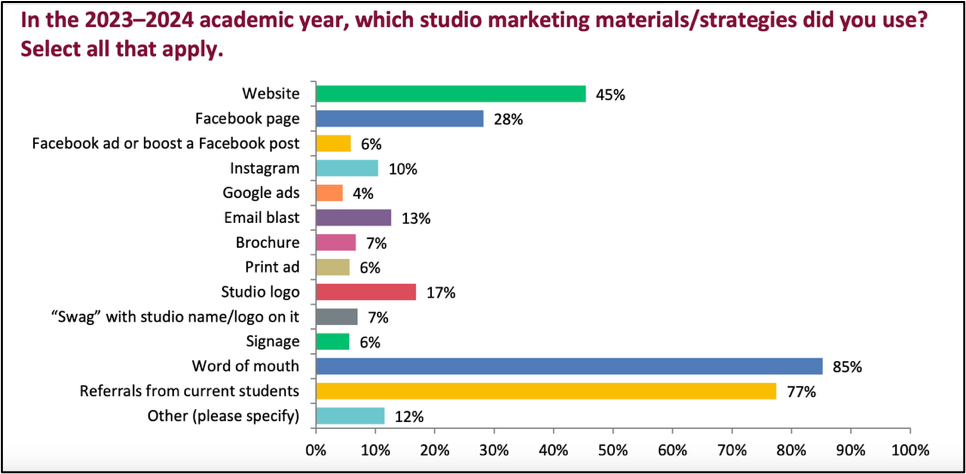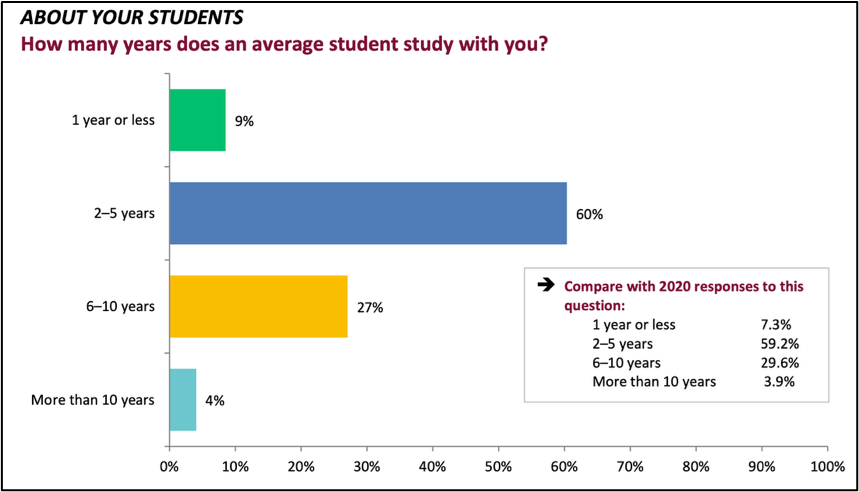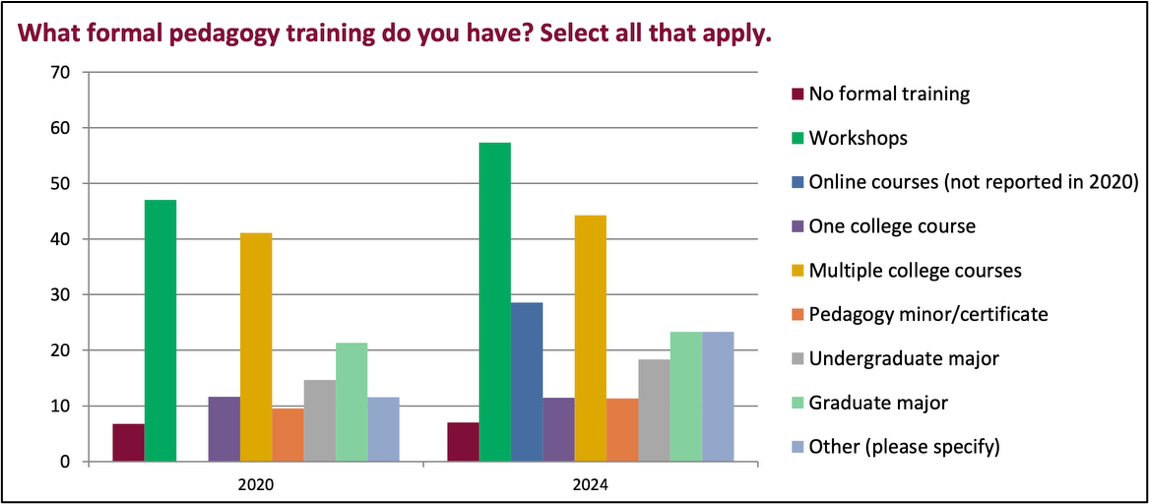In the Spotlight:
“Survey Says…”
What We Can Learn from the 2024 MTNA Member Survey
Ryan Greene and Karen Thickstun, NCTM
MTNA Business Digest, Volume 5, Issue 1
October 2025
What do members report as the most important challenge to independent music teachers? How much have average lesson rates increased since COVID? Keep reading to learn what the “survey says…”
Much like a live performance, a benchmarking survey captures a single moment in time and takes a snapshot of our profession and its members.
In fall 2024, MTNA conducted its third benchmarking survey, following surveys conducted in 2020 and 2005. All survey results are archived in the Business Resources section of the MTNA website. The 2024 MTNA Member Survey results are presented in two formats: a Highlights version (22 pages) and a Summary version (84 pages)
Federal Trade Commission (FTC) guidelines were followed carefully throughout the survey process, including only collecting anonymous historical data and reporting results in aggregate form.
Why Does MTNA Conduct Member Surveys?
MTNA conducts member surveys to gather data about the approaches members have regarding issues such as rates, make-up lessons, marketing, insurance, etc., and to make this aggregate data available to members. It provides teachers with relevant information about the music teaching profession as a measure to validate, examine, and improve one’s studio business.
As a benchmarking tool, a member survey allows MTNA to identify ways to better serve its membership and the profession by recognizing and addressing changes/trends. How are our services, programs, and benefits received? What are the needs and priorities of our members?
Regular surveys can highlight and track trends, such as types of repertoire being taught or the percentage of students using digital instruments. The value of gathering data over time is well represented in the top responses to the question, “What will be the most important challenges to independent music teachers in the next few years?”:
- 2005: maintaining student interest, teacher education maintenance, studio growth
- 2020: overscheduled students, student motivation, public health
- 2024: overscheduled students, a livable income, lack of understanding of the value of music teaching/study, student motivation
Members can also utilize the survey results as an educational tool. For example, a teacher might discover new ideas for how to offer make-up lessons, collect payments, or utilize social media in their studio.
MTNA 2024 Member Survey Results
The authors have analyzed the MTNA 2024 Member Survey results in depth and share their personal insights in this article. They encourage each member to read the survey results on their own and identify their own insights, as every teacher will have different takeaways.
A few caveats:
- Italicized text represents the personal opinions/insights of the authors, not those of MTNA.
- Comparisons in this article are between the 2020 and 2024 MTNA Member Surveys. We acknowledge two data points do not confirm a trend; however, they do indicate areas of change that may bear watching. As MTNA conducts future surveys, additional data points may confirm or refute trends.
- Survey results reflect input from participating MTNA members, which may or may not mirror perspectives of the profession as a whole.
Let’s dive in!
A sampling of results reported by independent teachers:
- Respondents reported an average 60-minute lesson rate in the 2034–2024 academic year of $65.72. The average 60-minute lesson rate reported in the 2020 survey was $56.58. When the 2020 figure is adjusted for inflation to 2024 dollars, it is $67.64. It appears, as a whole, that 2024 hourly rates are slightly down. This might be an anomaly. We wonder if teachers did not raise rates during/after COVID, and then when they did raise rates in more recent years, it wasn’t enough of a raise to make up for the COVID years. In the Summary version of the survey results (page 29), you can find average rates by state and division, which range from the lowest rate of $44.71 in Wyoming to the highest rate of $92 in the District of Columbia.

- 17% of respondents reported they raised rates annually, 32% raised them every 2 years, 34% raised them every 3–5 years, 7% raised them every 6–10 years, and 11% never raise their rates. Comparison to the 2020 survey results* indicates teachers are raising rates more often and fewer are never raising rates. (*Comparison to 2020 not available for every 6-10 years.)

- Most respondents still report earning gross annual teaching income of less than $25,000. The promising news is that fewer teachers in 2024 reported income of less than $25,000 (compared to 2020), and more teachers reported income levels of $51,000–75,000 and $76,000–100,000 (compared to 2020).

- Awareness of zoning regulations appears to be declining. In 2020, 48% of teachers reported they are aware of zoning laws that apply to their area, while in 2024, only 44% said they are aware.
- Among respondents, lesson demand appears strong. 43% of teachers had a waitlist and averaged 7 students on the list, compared to 35% with a waitlist of 5.5 students in 2020.
- Retention also appears to be increasing. 52% of teachers reported their average student has been with them 6–10 years (compared to 50.6% in 2020).
-
For marketing, more teachers reported using a website (45% in 2024, 39% in 2020), Facebook page (28% in 2024, 27% in 2020), and Instagram (10% in 2024, 7% in 2020). The top two marketing strategies continue to be word-of-mouth (85%) and referrals (77%).

Recognizing that the hours worked by teachers involve far more than the actual lesson time, a new question was asked in the 2024 survey about how teachers spend their time:
| Average time spent per week teaching lessons/classes |
16.6 hours |
| Average time spent per week preparing for lessons |
3.8 hours |
| Average time spent per week on services* |
4.4 hours |
| Average time spent per week on bookkeeping/business tasks |
2.8 hours
|
| TOTAL average time per week |
27.6 hours |
*Services = recitals, performance classes, computer lab, theory classes, summer camps, music exams, festivals/competitions, etc.
The IRS considers “full-time” to be 30 or more hours per week. In a separate question, 34% of respondents self-described as full-time and 66% as part-time. The total average time per week reported above (27.6 hours) is consistent with a respondent pool of mostly part-time teachers. However, the hours reported for non-teaching tasks seem low to us. It’s quite possible these hours are not something teachers regularly or meticulously track. It will be interesting to compare these results with future surveys.
In the Summary version of the 2024 results, there is a group teaching section that includes information about ages, lesson lengths, group sizes, rates, and more (p. 21, 30).
The Summary version also takes a deeper dive into independent studio business practices:
- Types of studio documents used (p. 7). Usage of studio policy and registration forms declined from 2020 to 2024. From a legal perspective, this is concerning.
- Communication strategies (p. 12). Text messaging edged higher than email in 2024.
- Post-COVID technologies/policies (p. 13). 49% of respondents are still using virtual lessons for student illness. Additionally, 40% require handwashing or sanitizing.
- Make-up lesson policies (p. 15). 55% of teachers allow make-up lessons for emergency reasons and/or advance notice.
- Make-up lesson options (p. 16). 28% of teachers offer online lessons (up from 19% in 2020). 84% reschedule lessons to a later date (down from 87% in 2020).
- Studio policies that involve legal issues (p. 17). Fewer teachers reported having photo/video releases (36% in 2020, 32% in 2024), sharing information about physical contact (11% in 2020, 8% in 2024), communicating about lesson termination (48% in 2020, 42% in 2024), and sharing information about the use of social media by the studio (23% in 2020, 18% in 2024). From a legal perspective, these declines are concerning.
- Billing frequency and payment methods (p. 24–25). Cash and check are still the most common payment methods offered, but 63% of teachers now offer CashApp/Venmo/Zelle, and 29% offer PayPal.
A sampling of results reported by teaching staff (music school/academy/community school, music/piano store, public or private K–12 setting):
- Similar to independent studios, lesson rates showed a small decline. The average 60-minute lesson rate for the 2034–2024 academic year was $80. The average 60-minute lesson rate in the 2020 survey was $66.87. When the 2020 figure is adjusted for inflation to 2024 dollars, it is $81.78.

- The average fee received by teaching staff was 63% of the lesson fee. This is a decline from 69% in 2020.
- Most respondents still report earning gross annual teaching income of less than $25,000. The promising news is fewer teachers in 2024 reported income of less than $25,000 (compared to 2020) and slightly more teachers reported income levels of $26,000–51,000 and $51,000–75,000 (compared to 2020). Comparing gross annual income for teaching staff to gross annual income for independent studios indicates that 61% of teaching staff are earning less than $25,000 while 44% of independent studios are earning less than $25,000. This is a difference worth considering if one is deciding whether to teach for someone else or open their own studio.
- Retention appears to be decreasing and is quite lower than reported by independent studios above. 27% of teachers reported their average student has been with them 6–10 years (compared to 29.6% in 2020).

- For marketing, teaching staff (or their institution) were more likely to use a website (80.3%) and Facebook page (55.2%) than independent teachers (45% website, 28.2% Facebook page). For teaching staff, word-of-mouth (74%) and referrals (66%) were not as strong as independent teachers (85% and 77%).

A sampling of results reported by higher education teachers:
- 51% teach full-time and 49% teach part-time, compared with 55% full-time and 45% part-time in 2020.
- Gross annual income levels in 2024 are mixed when compared to 2020, with some income ranges seeing gains (significantly, those earning $76,000–100,000) and others seeing declines (significantly, those earning $51,000–75,000).

- In addition to higher education income, teachers reported income from adjudicating (71% of respondents), performing (62%), workshops/lectures (45%), accompanying (43%), and religious services (39%).
A sampling of results reported by retired members:
61% of retirees reported that they felt “well-prepared” for retirement and 28% felt “prepared.” Retirees primarily prepared for retirement with personal savings/investments (66% of respondents) and personal IRA/Roth or similar plan (61%).
Top reasons that retirees maintain their MTNA membership include:
- To stay current with friends and past colleagues/sense of community (75%)
- To support the organization/profession (73%)
- To stay current with new developments/trends in the profession (68%)
- Lifelong learning (65%)
55% of retirees reported remaining active at the local, state, or national level. 48% reported being unaware that MTNA has a retired membership category.
A sampling of results about current trends and community engagement:
As the profession evolves, types of students and teaching topics change. More than 70% of respondents rated wellness/injury prevention and adult music study to be of great importance to their studios (p. 70). 60% offered programs or lessons for older adults (p. 73). We encourage readers to explore the full list of topics on pages 70 and 73 in the Summary version as possible areas of innovation in your studios/teaching.
In general, respondents shared they did not know who their community leaders are, were not aware of how their state legislature funds the arts, and have not advocated on behalf of the arts to local or state leaders (p. 74). We hope that teachers will be encouraged to learn more about arts advocacy in their community. If we do not advocate for the arts, how can we expect our elected officials to support the arts? The good news is that more than 65% of respondents can see themselves playing a significant role in supporting the arts in their community. This indicates an area of opportunity for MTNA to assist members with advocacy strategies.
Compared to 2020, more teachers in 2024 are receiving formal pedagogy training from workshops and online courses. A slight increase is reported for undergraduate and graduate majors (p. 76). It is encouraging that teachers are valuing professional development in pedagogy.

In conclusion
Please keep in mind—these are just a few of the many results compiled for the MTNA 2024 Member Survey. Every member will find different items of interest. Click here and continue exploring for insights useful to your teaching situation. What interesting things will you discover?
Please watch for future surveys from MTNA and take the time to participate. As the 2024 survey demonstrates, your responses are important for providing accurate and comprehensive results that benefit everyone.

Ryan Greene is Director of Membership Development for MTNA. He teaches piano at the Music Academy of Centerville. Greene holds degrees in piano performance and pedagogy from Southern Methodist University and Butler University.

Karen Thickstun, NCTM, is retired professor of piano pedagogy at Butler University and founding director of the Butler Community Arts School. She coordinates the MTNA Business Resources program and is MTNA past president.